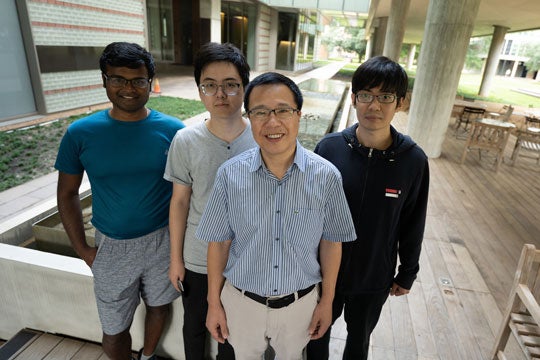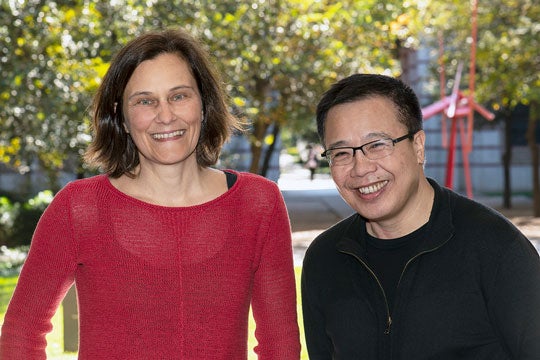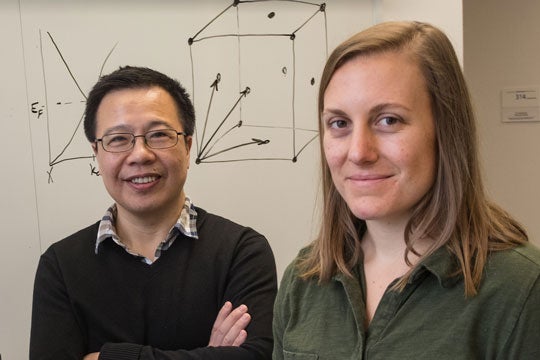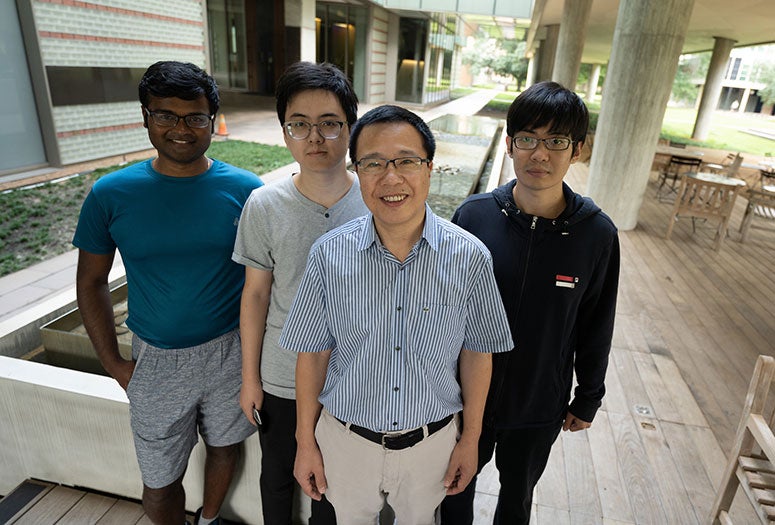HOUSTON – (Sept. 15, 2022) – U.S. and European physicists have demonstrated a new method for predicting whether metallic compounds are likely to host topological states that arise from strong electron interactions.

Physicists from Rice University, leading the research and collaborating with physicists from Stony Brook University, Austria’s Vienna University of Technology (TU Wien), Los Alamos National Laboratory, Spain’s Donostia International Physics Center and Germany’s Max Planck Institute for Chemical Physics of Solids, unveiled their new design principle in a study published online today in Nature Physics.
The team includes scientists at Rice, TU Wien and Los Alamos who discovered the first strongly correlated topological semimetal in 2017. That system and others the new design principle seeks to identify are broadly sought by the quantum computing industry because topological states have immutable features that cannot be erased or lost to quantum decoherence.
“The landscape of strongly correlated topological matter is both large and largely uninvestigated,” said study co-author Qimiao Si, Rice’s Harry C. and Olga K. Wiess Professor of Physics and Astronomy. “We expect this work will help guide its exploration.”

In 2017, Si’s research group at Rice carried out a model study and found a surprising state of matter that hosted both topological character and a quintessential example of strong-correlation physics called the Kondo effect, an interaction between the magnetic moments of correlated electrons confined to atoms in a metal and the collective spins of billions of passing conduction electrons. Concurrently, an experimental team led by TU Wien’s Silke Paschen introduced a new material and reported that it had the same properties as those in the theoretical solution. The two teams named the strongly correlated state of matter a Weyl-Kondo semimetal. Si said crystalline symmetry played an important role in the studies, but the analysis stayed at the proof-of-principle level.
“Our 2017 work focused on a sort of hydrogen atom of crystalline symmetry,” said Si, a theoretical physicist who’s spent more than two decades studying strongly correlated materials like heavy fermions and unconventional superconductors. “But it set the stage for designing new correlated metallic topology.”
Strongly correlated quantum materials are those where the interactions of billions upon billions of electrons give rise to collective behaviors like unconventional superconductivity or electrons that behave as if they have more than 1,000 times their normal mass. Though physicists have studied topological materials for decades, they have only recently begun investigating topological metals that host strongly correlated interactions.

“Materials design is very hard in general, and designing strongly correlated materials is harder still,” said Si, a member of the Rice Quantum Initiative and director of the Rice Center for Quantum Materials (RCQM).
Si and Stony Brook’s Jennifer Cano led a group of theorists that developed a framework for identifying promising candidate materials by cross-referencing information in a database of known materials with the output of theoretical calculations based on realistic crystal structures. Using the method, the group identified the crystal structure and elemental composition of three materials that were likely candidates for hosting topological states arising from the Kondo effect.
“Since we developed the theory of topological quantum chemistry, it has been a longstanding goal to apply the formalism to strongly correlated materials,” said Cano, an assistant professor of physics and astronomy at Stony Brook and research scientist at the Flatiron Institute’s Center for Computational Quantum Physics. “Our work is the first step in that direction.”
Si said the predictive theoretical framework stemmed from a realization he and Cano had following an impromptu discussion session they organized between their respective working groups at the Aspen Center for Physics in 2018.

“What we postulated was that strongly correlated excitations are still subject to symmetry requirements,” he said. “Because of that, I can say a lot about the topology of a system without resorting to ab initio calculations that are often required but are particularly challenging for studying strongly correlated materials.”
To test the hypothesis, the theorists at Rice and Stony Brook carried out model studies for realistic crystalline symmetries. During the pandemic, the theoretical teams in Texas and New York had extensive virtual discussions with Paschen’s experimental group at TU Wien. The collaboration developed the design principle for correlated topological-semimetal materials with the same symmetries as used in the model studied. The utility of the design principle was demonstrated by Paschen’s team, which made one of the three identified compounds, tested it and verified that it hosted the predicted properties.
“All indications are that we have found a robust way to identify materials that have the features we want,” Si said.
Study co-authors include Lei Chen, Chandan Setty and Haoyu Hu of Rice; Rice alumna Sarah Grefe ’17 of Los Alamos National Laboratory; Lukas Fischer, Xinlin Yan, Gaku Eguchi and Andrey Prokofiev of TU Wien; and Maia Vergniory of both the Max Planck Institute for Chemical Physics of Solids in Dresden, Germany, and the Donostia International Physics Center in Donostia-San Sebastian, Spain.
The research at Rice was supported by the Air Force Office of Scientific Research (FA9550-21-1-0356), the National Science Foundation (DMR-2220603, EIA-0216467, CNS-1338099, DMR-170109, PHY-1607611), the Welch Foundation (C-1411) and Rice’s Shared University Grid computing facilities, and benefited from the hospitality of the Aspen Center for Physics.
- Peer-reviewed paper
-
“Topological semimetal driven by strong correlations and crystalline symmetry” | Nature Physics | DOI: 10.1038/s41567-022-01743-4
Lei Chen, Chandan Setty, Haoyu Hu, Maia G. Vergniory, Sarah E. Grefe, Lukas Fischer, Xinlin Yan, Gaku Eguchi, Andrey Prokofiev, Silke Paschen, Jennifer Cano and Qimiao Si
- Image downloads
-
https://news-network.rice.edu/news/files/2022/09/0915_TOPOSEMI-grp26-lg.jpg
CAPTION: Rice University physicists (from left) Chandan Setty, Lei Chen, Qimiao Si and Haoyu Hu at Rice in September 2022. (Photo by Jeff Fitlow/Rice University)https://news-network.rice.edu/news/files/2022/09/0915_TOPOSEMI-21spqm8tl-lg.jpg
CAPTION: Physicists Silke Paschen (left) of Vienna University of Technology and Qimiao Si of Rice University at Rice in November 2021. (Photo by Tommy LaVergne/Rice University)https://news-network.rice.edu/news/files/2022/09/0915_TOPOSEMI-17qmsg8-lg.jpg
CAPTION: Rice University physicist Qimiao Si (left) and Los Alamos National Laboratory physicist Sarah Grefe at Rice in December 2017. (Photo by Jeff Fitlow/Rice University)https://news-network.rice.edu/news/files/2022/09/0915_TOPOSEMI-jc-lg.jpg
CAPTION: Jennifer Cano is an assistant professor of physics and astronomy at Stony Brook University and a research scientist at the Flatiron Institute’s Center for Computational Quantum Physics. (Photo courtesy of J. Cano/Stony Brook University) - Related stories
-
Pristine quantum criticality found – May 24, 2021
https://news.rice.edu/2021/05/24/pristine-quantum-criticality-found/Quantum quirk yields giant magnetic effect, where none should exist – Feb. 26, 2021
https://news.rice.edu/2021/02/26/quantum-quirk-yields-giant-magnetic-effect-where-none-should-exist/Study finds billions of quantum entangled electrons in ‘strange metal’ – Jan. 16, 2020
https://news.rice.edu/2020/01/16/study-finds-billions-of-quantum-entangled-electrons-in-strange-metal/Quantum criticality could be a boon for qubit designers – Aug. 23, 2019
https://news.rice.edu/2019/08/23/quantum-criticality-could-be-a-boon-for-qubit-designers/Rice U. physicists discover new type of quantum material – Dec. 18, 2017
https://news2.rice.edu/2017/12/18/rice-u-physicists-discover-new-type-of-quantum-material/ - About Rice
-
Located on a 300-acre forested campus in Houston, Rice University is consistently ranked among the nation’s top 20 universities by U.S. News & World Report. Rice has highly respected schools of Architecture, Business, Continuing Studies, Engineering, Humanities, Music, Natural Sciences and Social Sciences and is home to the Baker Institute for Public Policy. With 4,240 undergraduates and 3,972 graduate students, Rice’s undergraduate student-to-faculty ratio is just under 6-to-1. Its residential college system builds close-knit communities and lifelong friendships, just one reason why Rice is ranked No. 1 for lots of race/class interaction and No. 1 for quality of life by the Princeton Review. Rice is also rated as a best value among private universities by Kiplinger’s Personal Finance.

